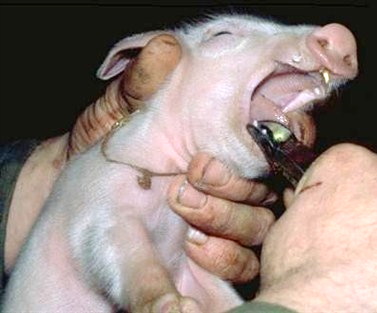Oral presentation
Recent Advances in Animal Welfare Science (VI),
UFAW Animal Welfare Conference, Centre for Life, Newcastle, UK 28th June 2018
Coexpression analysis of dorsal root ganglia from tail amputated pigs at different ages reveals long-term transcriptional signatures associated with wound healing and inflammation, and neuropathic pain pathways
DA Sandercock1, JE Coe1, MW Barnett2, TC Freeman2, P Di Giminiani3 and SA Edwards3
1 Animal and Veterinary Science Research Group, SRUC, Edinburgh UK,
2 The Roslin Institute and Royal (Dick) School of Veterinary Studies, University of Edinburgh, Edinburgh UK
3 School of Agriculture, Food and Rural Development, Newcastle University, Newcastle-upon-Tyne, UK
Concerns exist that docking and biting injuries may be a cause of long term pain in the remaining tail stump during the pig’s lifetime. The potential for long-term pain has been linked to sustained cellular and molecular changes in peripheral sensory neuronal activity. The aim of this study was to conduct a transcriptome analysis of caudal dorsal root ganglia (DRG) gene expression profiles from pigs subjected to tail amputation, in particular examining genes known to be associated with inflammation and neuropathic pain. Microarray analysis was performed on caudal DRG from sham (control) and tail amputated pigs 1, 8 and 16 weeks after tail treatment at either 3 days (neonate) or 63 days (juvenile). Tail amputation injury induced highly significant gene expression changes (both up and down) compared to sham-treated intact controls at both ages (518-2,794 genes, FDR < 0.05) that were still evident 16 weeks after tail amputation. Network correlation analysis using the Markov clustering (MCL) algorithm to define expression modules revealed two highly correlated (PCT r2 = ≥0.75), interrelated transcript expression clusters related to (A) neuronal function (759 genes) and (B) wound healing (273 genes). In cluster A, gene ontology (GO) and pathway enrichment analysis identified genes with significant GO terms for voltage- and ligand-gated ion channel activity linked to regulation of membrane potentials, neurotransmitter levels and synaptic signalling. In cluster B significant gene expression was associated with receptor binding, protein transcription activity and regulation, linked to processes such as response to wounding, regulation of response to wounding, inflammatory response and activation of immune response. Cross-reference against an integrated database of known genes involved in the regulation of inflammatory and neuropathic pain revealed 124 and 61 pain–associated genes in clusters A and B, respectively. Key functional families of ion channels and receptors were significantly down-regulated in cluster A, in particular voltage-gated potassium channels and GABA receptors which are linked to increased neuronal excitability. Up-regulated functional gene families in cluster B were mostly linked to inflammation, macrophage activity, neurohormone and opioid peptide activity. DRG gene expression profiles appear to be linked to sustained tissue inflammation and remodelling (ca. 4 months) and pain perception modulation consistent with adaptive, compensatory responses to injury induced increases in peripheral sensory neuron excitability in the injured tail stump. Tail amputation causes acute and sustained changes in peripheral somatosensory nerve function involving inflammatory and neuropathic pain pathways which have implications for pig welfare.

